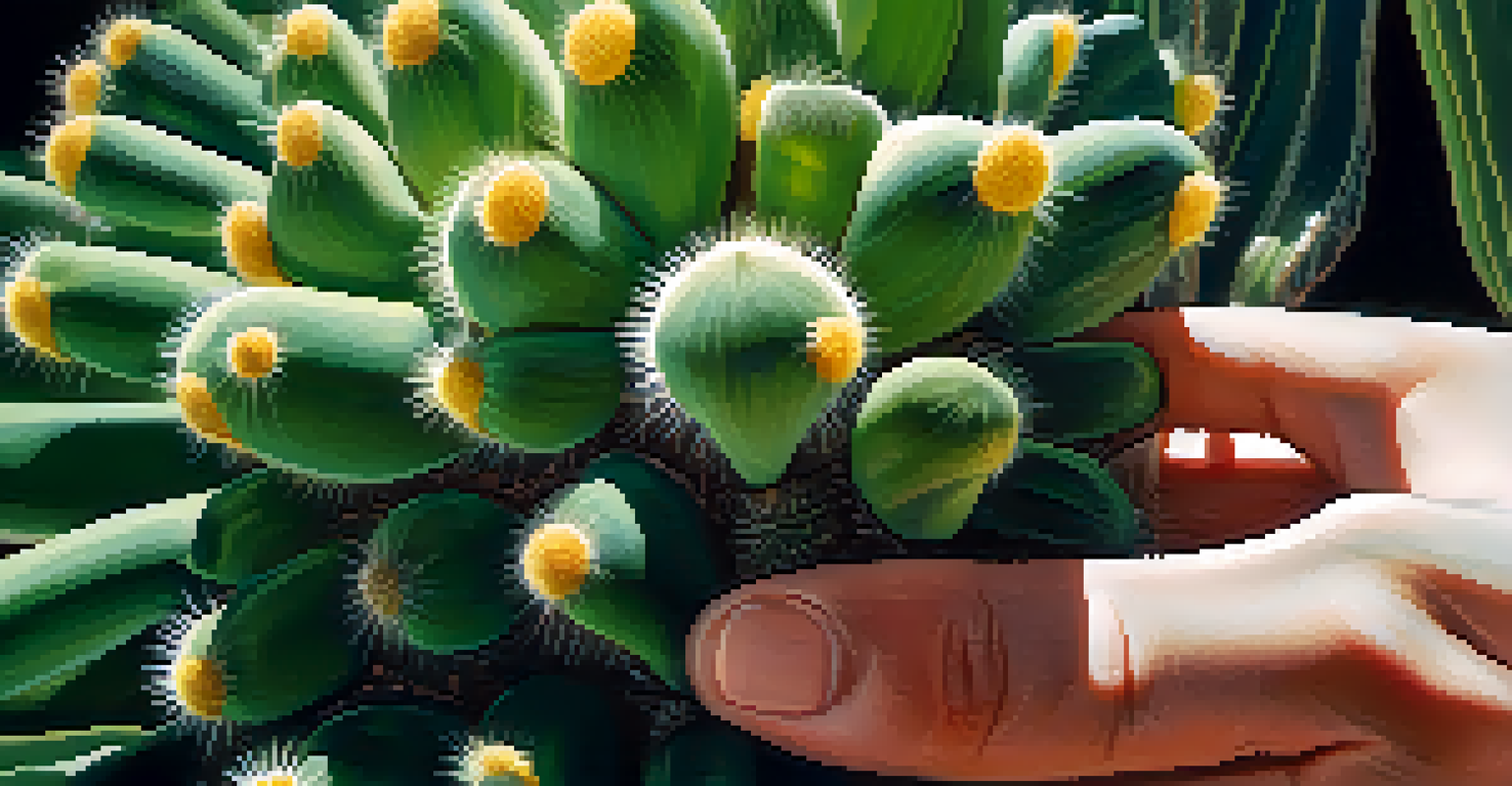Understanding Peyote: The Intersection with Ancestor Veneration

What is Peyote? An Introduction to the Sacred Cactus
Peyote, a small, spineless cactus native to Mexico and the southwestern United States, has been used for thousands of years in spiritual ceremonies. Known scientifically as Lophophora williamsii, this cactus contains mescaline, a psychoactive compound that induces altered states of consciousness. Many indigenous cultures regard peyote as a sacred plant, integral to their spiritual practices and connection to the divine.
The ancestors are always with us, guiding us and reminding us of who we are.
The use of peyote is deeply rooted in the traditions of various Native American tribes, particularly the Huichol and the Navajo. For these communities, peyote serves not only as a source of spiritual insight but also as a means of healing and renewal. By consuming peyote, individuals often seek guidance from their ancestors and the spiritual world, making it a vital part of their cultural heritage.
Understanding peyote is essential to appreciating its role in ancestor veneration. This intersection illustrates how the plant acts as a bridge between the physical and spiritual realms, allowing practitioners to connect with their lineage and seek wisdom from those who came before them.
The Importance of Ancestor Veneration in Indigenous Cultures
Ancestor veneration is a significant practice in many indigenous cultures, where the deceased are honored and remembered as guiding forces in the lives of their descendants. This reverence stems from the belief that ancestors continue to influence the living, offering protection, wisdom, and insight. In many cases, rituals and ceremonies are performed to maintain this connection, reinforcing the bonds between generations.

For Native American tribes, ancestor veneration often involves storytelling, music, and dance, creating a rich tapestry of cultural expression. These practices serve to keep the memories of ancestors alive, allowing their teachings and experiences to resonate within the community. In this way, the past is not seen as distant but as an integral part of the present.
Peyote as a Sacred Plant
Peyote, a spineless cactus, is revered in various indigenous cultures for its psychoactive properties that facilitate spiritual connection and ancestor veneration.
By incorporating peyote into their rituals, practitioners can deepen their connection to their ancestors. The altered states induced by peyote can facilitate communication with the spiritual realm, allowing individuals to receive guidance and wisdom from those who have passed on.
How Peyote Facilitates Spiritual Connection
The psychoactive properties of peyote are central to its role in spiritual practices. When consumed, peyote can induce visions and altered perceptions, providing individuals with profound insights into their lives and their ancestral connections. This experience is often described as a journey, where the practitioner explores their inner self and the spiritual world.
Peyote is a way to see the world through the eyes of our ancestors, connecting us to the wisdom of the past.
During peyote ceremonies, participants often share their experiences and visions, creating a communal atmosphere that reinforces the shared cultural heritage. These gatherings serve as both a spiritual and social event, fostering a sense of unity among participants. The group dynamic enhances the individual experiences, allowing for collective healing and understanding.
In essence, peyote acts as a catalyst for spiritual exploration, enabling practitioners to confront personal challenges and seek guidance from their ancestors. This connection not only enriches individual experiences but also strengthens community ties, ensuring that cultural traditions continue to thrive.
Rituals Involving Peyote and Ancestor Veneration
Rituals involving peyote often include a series of structured practices designed to honor ancestors and facilitate spiritual connection. These ceremonies can take many forms, from intimate family gatherings to larger community events. Each ritual typically involves prayer, singing, and the sharing of stories about ancestors, creating a rich narrative that links the past to the present.
Participants may consume peyote in a controlled environment, guided by a spiritual leader or elder who helps navigate the experience. This guidance is crucial, as the journey can be intense and requires a supportive atmosphere. The elder's role is to ensure that participants remain grounded and connected to the purpose of the ceremony.
Importance of Ancestor Veneration
Ancestor veneration is crucial in indigenous cultures, where honoring the deceased fosters a continuous connection that influences the living through rituals and storytelling.
Through these rituals, the act of consuming peyote becomes more than just a personal experience; it transforms into a celebration of heritage and community. Ancestor veneration is woven into the fabric of these ceremonies, highlighting the importance of honoring those who have come before us.
Cultural Challenges and the Misunderstanding of Peyote Use
Despite its significance in indigenous cultures, the use of peyote has faced challenges and misunderstandings, particularly from outsiders. Many people view peyote solely as a recreational drug, overlooking its deep-rooted spiritual and cultural importance. This misconception can lead to the appropriation of sacred practices, diluting their meaning and significance.
Legal restrictions surrounding peyote further complicate its use in spiritual ceremonies. While some jurisdictions allow for its use in religious contexts, others impose strict regulations that limit access for indigenous communities. This creates tension between the preservation of cultural practices and the imposition of external laws, making it difficult for many to engage in their sacred traditions.
Addressing these misunderstandings is vital for fostering respect and appreciation for indigenous cultures. By educating others about the cultural significance of peyote and ancestor veneration, we can begin to bridge the gap between different perspectives and promote a greater understanding of these rich traditions.
The Role of Peyote in Modern Spiritual Practices
In recent years, there has been a resurgence of interest in peyote and its role in spiritual practices beyond indigenous communities. Many individuals seeking personal growth and healing have turned to peyote as a means of exploring their spirituality. This trend has sparked conversations about the ethical implications of using a sacred plant outside its traditional context.
As more people engage with peyote, it's essential to recognize the need for respectful practices that honor its cultural origins. This includes seeking guidance from indigenous leaders and participating in ceremonies with an understanding of their significance. By approaching peyote use with reverence, individuals can cultivate a more authentic connection to the plant and its spiritual dimensions.
Modern Interest and Ethical Concerns
A resurgence of interest in peyote for personal growth raises ethical questions about its use outside traditional contexts, highlighting the importance of respecting its cultural origins.
Ultimately, the intersection of peyote and ancestor veneration continues to evolve, reflecting the diverse ways in which people seek connection to their past and their lineage. As we navigate this landscape, it's crucial to remain mindful of the cultural heritage that shapes these practices and to honor the voices of those who have long held these traditions.
Conclusion: Honoring the Past Through Peyote and Ancestor Veneration
In conclusion, the relationship between peyote and ancestor veneration is a profound testament to the resilience of indigenous cultures. By understanding the significance of peyote in spiritual practices, we can appreciate how it acts as a bridge between generations, allowing individuals to connect with their ancestors and draw wisdom from their experiences. This connection is vital for preserving cultural heritage and fostering a sense of belonging.
The rituals surrounding peyote consumption are not just about the plant itself; they embody a rich tapestry of history, spirituality, and community. As we learn more about these practices, we gain insight into the values and beliefs that shape the lives of those who honor their ancestors through peyote. This understanding can deepen our appreciation for diverse cultural traditions and promote respect for their significance.

Ultimately, as we honor the past through peyote and ancestor veneration, we not only support the continuation of these traditions but also enrich our own understanding of spirituality and connection. Embracing these practices with respect and openness allows us to celebrate the shared human experience and the wisdom that flows from our ancestors.